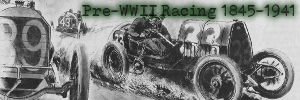















BOOK REVIEW: BROOKLANDS |
|---|
 Topics: Brooklands
Topics: Brooklands
|
Ed Monroe
Antique Automobile
March-April 1972
by P.J. Wallace
160 pages, 5¼ x 8¼ inches. Well illustrated. Ballantine Books Inc., 101 Fifth Avenue, New York, N.Y. 10003. Soft covers; $1.00 at your local book store.
Brooklands, which is designated as Special Book No. 1 in Ballantine's Illustrated History of the Car series, was the name given to England's most famous race course for motor cars. Completed in 1907, it was located near the Weybridge Station on the London & South-Western Railway, about twenty miles from London's Waterloo Station on the way to Southhampton. It was in constant use by motor vehicles until 1939.
About half way through the book, the author states it was not his intention to present a chronological history but rather to attempt an overall picture of what went on and the purposes which were served. In this respect he succeeds in presenting a fascinating account of Brooklands as he vividly recalls the thrills and excitement in sports car racing history that evolved there. Brooklands did play a vital role in the development of the European automobile, and for years The Autocar ran all its road tests at this famous locale.
P.J. Wallace, an engineer who worked with many of the early manufacturers of motor cycles, aircraft and aero engines, got to know Brooklands quite immediately as a result of his motorcycle racing experiences on its none too smooth surface. It is his opinion that the active life of this famed race course passed through three phases: the first was the development stage from 1907 to the outbreak of World War I in 1914; the second phase extended from 1920 to 1925, when extemporized hazards culminated in additional track length and a "mountain" circuit; and then in the final phase, when "speeds in the neighborhood of 140 mph. would cease to be exceptional". Such familiar names as Louis Coatalen, Henry Segrave, Percy Lambert, Chitty Chitty Bang Bang, and Parry Thomas and his "Babs" provide an insight into the atmosphere of friendliness and mutual assistance among drivers and engineers that made Brooklands unique.
This volume, like others in the Ballantine Series, is packed with interesting period photographs and drawings. Although some may lack contrast, they do provide full coverage of the vintage period in British motor racing history. Summarizing, it would be difficult to find a book of similar scope on the subject of Brooklands at such a remarkably low price.
C.B.
